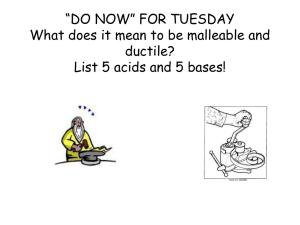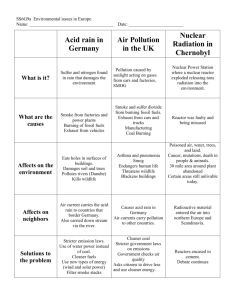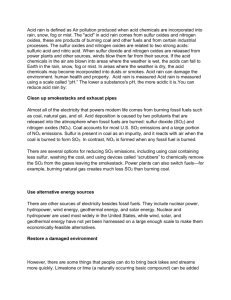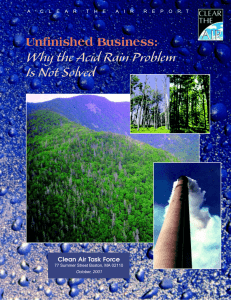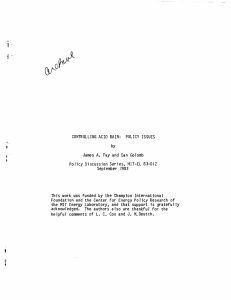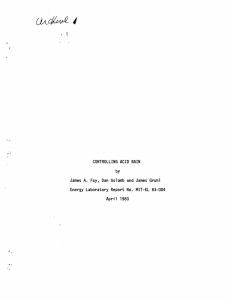Acid Rain
advertisement
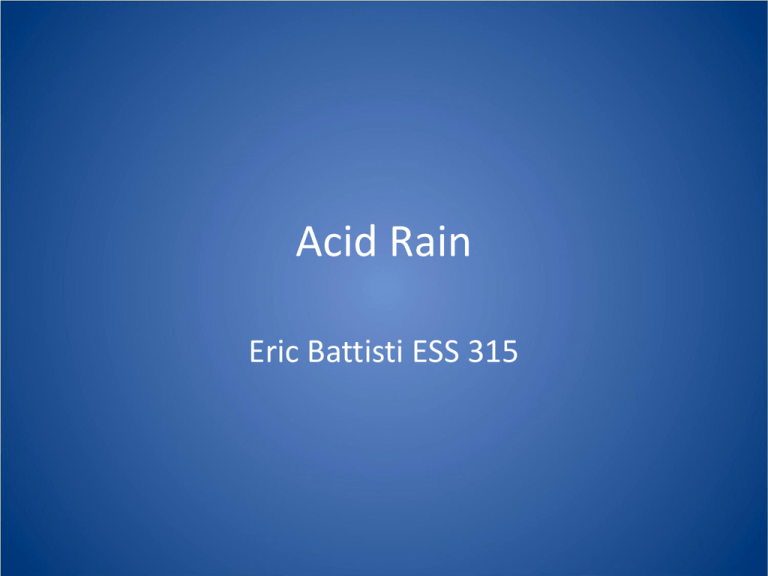
Acid Rain Eric Battisti ESS 315 Acid Deposition • Acid Rain refers to the deposition of acidic components in either wet or dry forms • Defined by the pH of the liquid. Less than 7 pH is acidic, more than 7 is basic • Natural acid rain can be caused by volcanic emissions and biological processes • “Clean” rain has a natural acidity of about 5.2 on the pH scale due to water reacting with carbon dioxide in the air to form carbonic acid • H2O (l) + CO2 (g) → H2CO3 (aq) • 2 H2O (l) + H2CO3 (aq) <–> CO32− (aq) + 2 H3O+ (aq) Human Attribution • Human emissions of sulfur dioxide and nitrogen oxides contribute to the acidification of rain • Emissions began during the industrial revolution, remaining unchecked until the 1970s • Biggest contributor is the burning of coal • Annually 70Tg (1012 g) of Sulfur emissions comes from fossil fuel burning, compared to 8Tg from volcanoes and 2.8Tg from wildfires The Coal Power Plant Problem • Burning coal is extremely cheap and efficient but dirty, releasing sulfur dioxide which becomes sulfuric acid in the atmosphere • Areas downwind of power plants receive heavy acid rain • Smoke stacks built to counteract direct deposition of sulfuric acid only spread the problem Effects of Acid Rain • Not many things can grow in acidic conditions • Low pH and high aluminum concentrations can damage or kill fish and aquatic populations • Soils can be damaged by the hydronium ion, which mobilizes aluminum and encourages leaching of minerals such as magnesium essential for plant life • Forests suffer from soil damage, however most food crops are unharmed because the nutrients lost are replaced in fertilizer Other Effects • Monuments made of Calcium Carbonate (limestone and marble) will react with acid rain to form Gypsum • Increases the oxidation rate of metals such as copper and bronze Areas of Highest Concern • Current problem areas are: • Eastern United States • South Western Canada • Eastern Europe • East Coast of China • Potential future problem areas: • Southern India • West Africa • Indonesia • Thailand Prevention • Coal burning power plants use Flue gas desulfurization requiring a reaction tower that extracts the sulfuric acid by reacting it with lime or limestone slurry and removing the product with scrubbers • Reduction in automotive emissions cuts down on nitrogen oxides • Emissions trading put into practice to put economic incentive into cleaning industrial activities Sources • • • • • • http://static.howstuffworks.com/gif/acid-rain-1a.jpg http://people.eku.edu/ritchisong/phfield.gif http://nadp.sws.uiuc.edu http://en.wikipedia.org/wiki/Acid_rain http://www.epa.gov/acidrain/effects/surface_water.html http://www.sfgate.com/cgibin/article.cgi?f=/c/a/2007/12/03/MNMMTJUS1.DTL&hw= Cap+trade+Acid+Rain&sn=001&sc=1000

